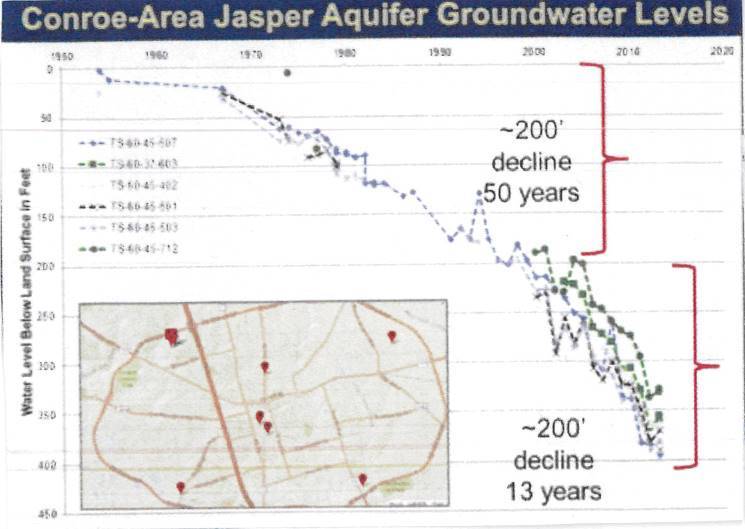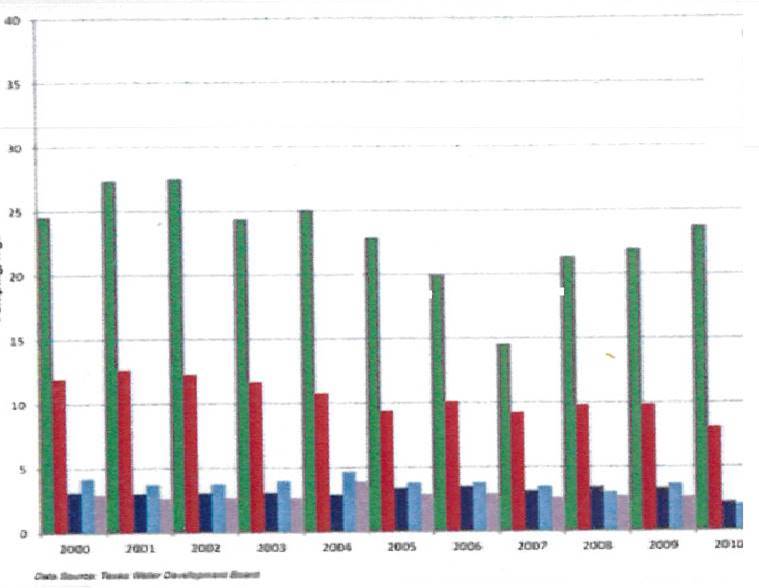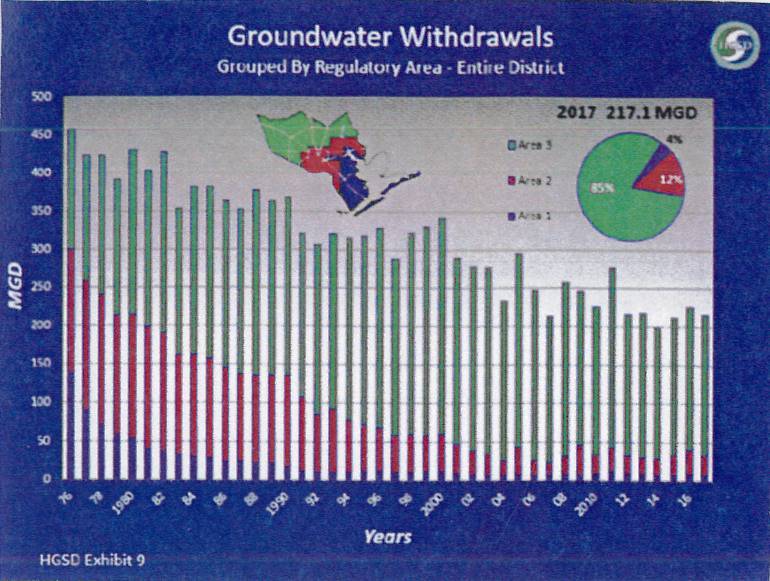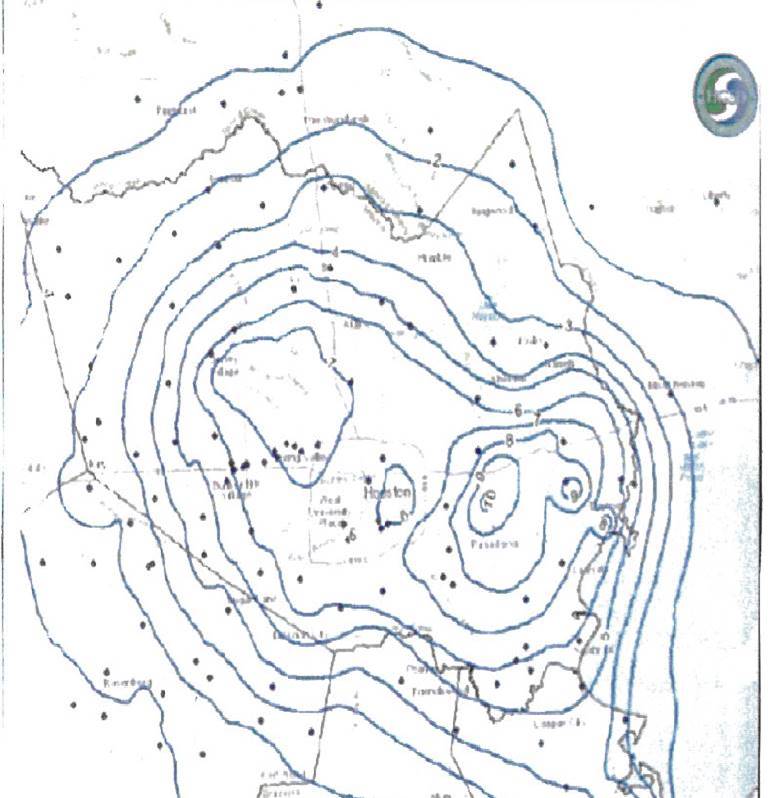Why Responsible Groundwater Management in Montgomery County Matters
October 2018
Source: Dock Line Magazine – Magnolia Edition October 2018
The problems associated with pumping too much water quickly from the aquifers in our region are well-documented. For over 50 years, utilities in Harris and surrounding counties have been limiting their groundwater pumpage and supplementing their supplies with surface water from nearby lakes because overreliance on ground water has led to declining water levels, which resulted in:
- Increased pumping costs, decreased well reliability, and in some cases water failures; and
- Sinking of the land surface due to subsidence, which increases the risk of flooding.
This article from December of 2016 is being updated and reprinted in order to educate citizens in Montgomery and surrounding counties about the serious, negative consequences that result from over-pumping our aquifers. This update also incorporates a new study recently completed by the Harris-Galveston Subsidence District that confirms water-level declines caused by over-pumping of our aquifers will result in subsidence of the land surface, which leads to increased flooding problems.
It is unfortunate, but not surprising, that there is significant confusion in Montgomery County over groundwater issues. For the past few years, two central-Texas consultants hired by the City of Conroe and Quadvest Utilities have been arguing that there is plenty of groundwater in our aquifers and that we don’t have a water supply problem that warrants the development of new supplies, such as the surface water treatment and delivery project implemented by over eighty utilities in the county. They contend that the major declines in groundwater levels experienced firsthand by our local water utilities are nothing to worry about and will actually help recharge the aquifers.
Conroe’s consultants are outliers among the many engineers and scientists that have studied our aquifers. And they’re simply wrong, We do have a water supply problem, and SJRA and other cities, towns, and utilities in the county have been working together for years to solve it.
SJRA has been relatively quiet during the current water debate and has not aggressively challenged the dubious claims of Conroe’s consultants for a couple of reasons.
First, we honestly didn’t believe they would be taken seriously. Their positions have no merit and are contradicted by state and federal agencies that study these issues without getting paid for reaching one conclusion over another. While these consultants have been dismissed out of hand by most water professionals in our region, the issue unfortunately remains controversial on a local political level.
Second, SJAR has been content to let the Lone Star Groundwater Conservation District respond to Conroe’s consultants, since lone Star is the agency charged by the Legislature with managing the aquifers in Montgomery County.
But in recent months, things have changed. Now, SJRA has been falsely accused of “conspiring” with Lone Star to “create” a water problem so it could somehow profit from building and running a surface water treatment plant on Lake Conroe. These accusations are entirely untrue, and so it’s no surprise that there is not a shred of evidence supporting them.
As a result, it has become necessary for SJRA to speak louder on this issue and point out some of the obviously false and misleading statements being made to the public by Conroe’s consultants.
1. Conroe’s hired consultants have argued over and over again, against all the science, that we don’t have a problem with our aquifers.
The claims of Conroe’s consultants that “there is plenty of water in the Gulf Coast aquifer” and that “continued water level declines will simply allow more water to recharge into the aquifer faster” are wrong, irresponsible, and contrary to the overwhelming guidance that engineers and hydrologists have given their utility clients in the Houston region for nearly seven decades.
The problems associated with water-level declines in the Houston region, including Montgomery County, have been studied since the mid-1900s. These problems are well-documented, not just by the Texas Water Development Board and the U.S. Geological Survey (USGS), but also by the local engineering community. Subsidence – that is, when the land sinks due to over-pumping of groundwater – is an obvious, serious and costly result of decline water levels, but it is hardly the only problem resulting from unchecked water-level declines.
Unless responsible actions are taken to manage the aquifers, the county faces water supply problems such as reduced well yields and increased concerns over the ability of existing wells to keep up with demand. Wells that have been reliable for years will require expensive overhauls or have to be replaced with even more expensive new wells. There are the facts. And you don’t just have to rely on Montgomery County’s experience. Hundreds of cities and water utilities in the greater Houston region have spent billions of dollars over the last 50 years to reduce their reliance on groundwater and develop alternate water supplies to meet their growing water demands. Montgomery County is only just now seeing the costs of increasing population and development that other utilities in our region experienced decades ago. They all use surface water to supplement and preserve their groundwater supply. They adopted forward-looking policies and solutions to avoid saddling future generations with even bigger problems. And they are all seeing water costs go up as a result, yet they choose to make the investment when the easy political choice would be to kick the can down the road.
For Conroe’s elected leaders and their consultants to now claim that there is “plenty of water” and “no problem” and that “entities should simply continue pumping” is irresponsible beyond explanation. Let’s just look at one example that shows how far Conroe’s consultants are willing to go to avoid the overwhelming evidence of the problems with our aquifers. It involves a June 1975 report by William F. Guyton and Associates prepared for Conroe and The Woodlands Development Company. Conroe’s consultants have frequently quoted from this report to point out that there are millions of acre-feet of water stored in our aquifers and that water-level declines in wells are just reductions in pressure and not reductions in storage. Their position is simple: there’s no tomorrow?
What is interesting is that they only quote the portions of the report that support their misleading arguments. Somehow, they missed portions of the report that support their misleading arguments. Somehow, they missed the portions of the report that point out the inherent limitations in using the aquifers and the problems that would likely occur in the future as pumpage increased. The fact is this 1975 report documented that the ability to reliably produce water from the aquifers in Montgomery County would be limited in the future.
In other words, local experts knew – over 40 years ago – that there would be a water problem with unfettered groundwater pumpage. These local experts have been proven right over the decades. The following figure shows how water levels have declined in Conroe’s wells, including almost 350 feet of decline after the publication of the 1975 Guyton report.

Figure 1. Water-level data from a sampling of Conroe-area wells shows the significant declines that have occurred
over the past 50-plus years.
2. Conroe’s consultants have falsely claimed that water utilities in Harris County are only reducing their groundwater pumpage because of the problem of land surface subsidence.
This is absolutely false, no matter how many times Conroe’s consultants repeat it. Subsidence is a big problem, but it’s only one of the problems that occurs as water levels decline. The bigger problem for water utilities is how declining water levels impact their ability to reliably produce enough water from their wells to meet the demands of their customers. It’s no help to have millions of acrefeet of water underground if no one can economically produce it, or if it’s coming out the well at a trickle. A prime example of how Conroe’s consultants are wrong is the North Harris County Regional Water Authority (NHCRWA). It recently borrowed $1.2 billion from the State of Texas to expand its existing surface water treatment and delivery system. This is its second phase of surface water conversion, and the NHCRWA is not expanding its system because of subsidence – it is doing it because its groundwater wells alone cannot keep up with demand.
3. Conroe’s consultants have falsely claimed that Montgomery County won’t have the same groundwater supply problems as Harris County because the Jasper aquifer is different.
Focused on selling their story that there is no water problem in the county, Conroe’s consultants have tried to distinguish Harris County’s groundwater problems from Montgomery County’s problems by arguing that Harris County uses a different aquifer. Once again, Conroe’s Consultants are content to tell the county’s citizens only half of the truth. It is true Harris County utilities primarily use the Chicot and Evangeline aquifers, but there are also utilities in north Harris County that use the Jasper Aquifer. These are the same three aquifers used by Montgomery County utilities. Plus, as pointed out in the 1975 Guyton report (though not by Conroe’s consultants), the Jasper aquifer has very similar geology and the same inherent limitations as the Evangeline. There are plenty of differences between Harris County and Montgomery County but when it comes to the aquifers, they share the same problems; and as explained in more detail below, the Jasper also shares the same rick of subsidence as the Chicot and Evangeline.
4. Conroe’s consultants say the Lone Star is out of step with how other districts manage their aquifers, but it’s Conroe’s consultants whose opinions are on the fringe.
Conroe’s consultants claim that Lone Star’s goal of reducing groundwater pumpage to amounts that will halt water-level declines is somehow unique and out of step with other groundwater districts in the region. They have argued repeatedly that Montgomery County’s “managed available groundwater” is unreasonable low in comparison to other counties in the state. Again, this just isn’t true. There are lots of counties in Texas with a lower managed available groundwater (MAG) than Montgomery County. Montgomery County actually has the fourth highest MAG out of the 20 counties in our region. Equally false is the claim that Montgomery County is somehow unique in how it manages its aquifers. Every groundwater district in the counties surrounding Montgomery County, including the two subsidence districts, all have the same goal for the Gulf Coast aquifer – namely, to reduce groundwater pumpage to levels that do not result in further water-level declines. The regulatory and permitting procedures for each district are not identical, but their management goals are. Figures 2 and 3 below show how counties surrounding Montgomery County have either decreased their groundwater pumping or kept it constant.

Figure 2. Groundwater pumping history for Waller, Liberty, Grimes, Walker, and San Jacinto counties.

Figure 3. Groundwater pumping history for Harris and Galveston counties.
5. One of Conroe’s consultants recently provided an affidavit in which he made erroneous statements regarding land surface subsidence in our area.
One of Conroe’s consultants recently stated that “No subsidence has ever been documented to have occurred or will ever occur from pumping groundwater from the Jasper Aquifer within Montgomery County or the other counties of GMA 14.” This statement is an astounding overreach with no support in science or fact. Here are the facts: (1.) as reported by the USGS, there is subsidence occurring across the southern half of Montgomery County, including in the Conroe area, (2) there is no monitor in Montgomery County that can distinguish subsidence in the Jasper from other layers of the aquifer, and (3) a recent report by the Harris-Galveston Subsidence District concludes that the Jasper aquifer will experience subsidence if it is over-pumped, particularly in the northern portions of the aquifer where it is being used for freshwater supply.
Conroe’s consultant claims no subsidence “has ever” or “will ever” occur in the Jasper “because the Jasper aquifer is a confined aquifer that is considerably deeper than the Chicot and Evangeline aquifers . . .” Even these supporting arguments are incorrect. First, the Chicot and Evangeline aquifers are both confined aquifers in the parts of our region where subsidence has occurred. Whether an aquifer is confined has nothing to do with subsidence in our region. It’s caused by depressurization due to removal of groundwater, and it occurs in confined aquifers. Furthermore, the Jasper is unconfined in some parts of GMA 14.
Second, the upper Jasper aquifer where we get our water supply is not “considerably deeper” than the portions of the Evangeline aquifer where pumpage and subsidence are occurring in Harris County. In fact, the depths overlap considerably.

Figure 4. This figure, produced by the Harris-Galveston Subsidence District, shows the total estimated amount of subsidence
that has occurred in the region from 1906 to 2016. Rainfall runoff in Montgomery County generally flows to the southeast toward Lake Houston, which means that subsidence is increasing the slope of rivers and creeks and is likely exacerbating flooding.
6. So What is the truth about the aquifers in Montgomery County?
We have a growing groundwater problem in our county, and it relates to both water supply and subsidence. It is the same problem utilities have been dealing with in Harris, Galveston, Fort Bend, and Brazoria counties since 1970’s. Our aquifers simply cannot produce enough water fast enough to keep up with increasing demand. When an area exceeds the reliable yield of the aquifer, water levels in wells begin to drop and can reach a point where the pumps have to be turned off or down-sized, which means the utility cannot keep up with demand. This has already happened to at least one utility in Montgomery County during the recent drought.
By repeating false and misleading claims for the past few years, Conroe’s consultants have tried to persuade the county’s citizens that Montgomery County doesn’t have the same groundwater problem that the rest of the counties around us have. They want county residents to believe that we are the only county where water has become more expensive, and that Lone Star is somehow an outlier in deciding to adopt regulations to limit groundwater pumpage and preserve the county’s water supply.
The fact is the only thing that is unique here is the inexplicable position of Conroe’s hired consultants that we should just keep on pumping the Gulf Coast aquifer despite ongoing water-level declines, while nearly every other city and water utility in the Houston region has already recognized the problem and taken steps to address it. Pretending a problem doesn’t exist won’t solve it, nor will it ensure that natural resource we’ve relied on for decades will be readily available decades in the future.